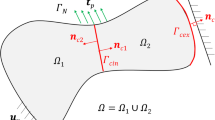Abstract
We present a method for computing an upper bound on the contact stress of elastic bodies. The continuum model of elastic bodies with contact is first modeled as a constrained optimization problem by using finite elements. An explicit formulation of the total contact force, a fraction function with the numerator as a linear function and the denominator as a quadratic convex function, is derived with only the normalized nodal contact forces as the constrained variables in a standard simplex. Then two bounds are obtained for the sum of the nodal contact forces. The first is an explicit formulation of matrices of the finite element model, derived by maximizing the fraction function under the constraint that the sum of the normalized nodal contact forces is one. The second bound is solved by first maximizing the fraction function subject to the standard simplex and then using Dinkelbach’s algorithm for fractional programming to find the maximum—since the fraction function is pseudo concave in a neighborhood of the solution. These two bounds are solved with the problem dimensions being only the number of contact nodes or node pairs, which are much smaller than the dimension for the original problem, namely, the number of degrees of freedom. Next, a scheme for constructing an upper bound on the contact stress is proposed that uses the bounds on the sum of the nodal contact forces obtained on a fine finite element mesh and the nodal contact forces obtained on a coarse finite element mesh, which are problems that can be solved at a lower computational cost. Finally, the proposed method is verified through some examples concerning both frictionless and frictional contact to demonstrate the method’s feasibility, efficiency, and robustness.
















Similar content being viewed by others

References
Wriggers P (2006) Computational contact mechanics. Springer, New York
Yastrebov VA (2013) Numerical methods in contact mechanics. Wiley-ISTE, London
Stein E, Ramm E, Rank E, Rannacher R, Schweizerhof K, Stein E, Wendland W, Wittum G, Wriggers P, Wunderlich W (2003) Error-controlled adaptative finite elements in solid mechanics. Wiley, New York
Paraschivoiu M, Peraire J, Patera AT (1997) A posteriori finite element bounds for linear-functional outputs of elliptic partial differential equations. Comput Methods Appl Mech Eng 150:289–312
Prudhomme S, Oden JT (1999) On goal-oriented error estimation for elliptic problems: Application to the control of pointwise errors. Comput. Methods Appl. Mech. Eng. 176:313–331
Ladevèze P, Pelle JP (2005) Mastering calculations in linear and nonlinear mechanics. Springer, New York
Xuan ZC, Parés N, Peraire J (2006) Computing upper and lower bounds for the J-integral in two-dimensional linear elasticity. Comput Methods Appl Mech Eng 195:430–443
Parés N, Bonet J, Huerta A, Peraire J (2006) The computation of bounds for linear-functional outputs of weak solutions to the two-dimensional elasticity equations. Comput Methods Appl Mech Eng 195:406–429
Parés N, Díez P, Huerta A (2013) Computable exact bounds for linear outputs from stabilized solutions of the advection-diffusion-reaction equation. Int J Numer Methods Eng 93:483–509
Ladevèze P, Pled F, Chamoin L (2013) New bounding techniques for goal-oriented error estimation applied to linear problems. Int J Numer Methods Eng 93:1345–1380
Liu GR, Zhang GY (2008) Upper bound solution to elasticity problems: a unique property of the linearly conforming point interpolation method (LCPIM). Int J Numer Methods Eng 74:1128–1161
Xuan ZC, Lassila T, Rozza G, Quarteroni A (2010) On computing upper and lower bounds on the outputs of linear elasticity problems approximated by the smoothed finite element method. Int J Numer Methods Eng 83:174–195
Jiang J, Liu GR, Zhang YW, Chen L, Tay TE (2011) A singular ES-FEM for plastic fracture mechanics. Comput Methods Appl Mech Eng 200:2943–2955
Liu GR, Jiang Y, Chen L, Zhang GY, Zhang YW (2011) A singular cell-based smoothed radial point interpolation method for fracture problems. Comput Struct 89:1378–1396
Glover F (1968) Surrogate constraints. Oper Res 16:741–749
Greenberg HJ, Pierskalla WP (1970) Surrogate mathematical programming. Oper Res 18:924–939
Xuan ZC, Lee KH (2003) Interior point surrogate dual algorithm for unilateral problems. Acta Mech 166:149–167
Xuan ZC, Lee KH (2004) Surrogate duality based method for contact problems. Optim Eng 5:59–75
Paulavičius R, Žilinskas J (2014) Simplicial global optimization. Springer, New York
Edelsbrunner H, Grayson DR Edgewise subdivision of a simplex. In: Proceeding SCG ’99 proceedings of the fifteenth annual symposium on computational geometry, pp 24–30
Gonçalves EN, Palhares RM, Takahashi RHC, Mesquita RC (2006) Algorithm 860: simpleS—an extension of Freudenthals simplex subdivision. ACM Trans Math Softw 32:609–621
Dinkelbach W (1967) On nonlinear fractional programming. Manag Sci 13:492–498
Acknowledgments
We would like to acknowledge the generous support for this research provided by the National Natural Science Foundation of China under grant number 11172209, and the first author would like to acknowledge the China Scholarship Council for generously supporting his visit to UC Berkeley.
Author information
Authors and Affiliations
Corresponding author
Rights and permissions
About this article
Cite this article
Xuan, Z., Papadopoulos, P. Computing an upper bound on contact stress with surrogate duality. Comput Mech 58, 171–183 (2016). https://doi.org/10.1007/s00466-016-1287-x
Received:
Accepted:
Published:
Issue Date:
DOI: https://doi.org/10.1007/s00466-016-1287-x



